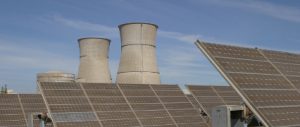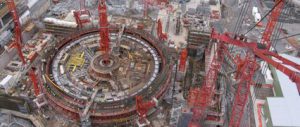Son Masayoshi is the chairman and chief executive of Softbank Corporation and representative director and president of Yahoo Japan Corporation. In September, he launched the Japan Renewable Energy Foundation. Read Andrew DeWit’s analysis of Son’s role in post-Fukushima Japan here.
The Great East Japan Earthquake left me deeply shocked. These days I carry a Geiger counter wherever I go and I was surprised that when I went to the Kansai region in south-central Japan, the device registered double digits. Radiation has now spread beyond the eastern regions of Tohoku and Kanto to the west as well.
As an operator of a cell-phone business, I was reminded by the earthquake and tsunami that, although cell phones are wireless, stations are wired with optical fibre cables and when these are broken or power fails, cell phones do not work at all. When we lose electricity and the network is crippled, cell phones go completely out of service.
Seeing cell-phone networks fail before my very eyes shocked me to my core. Lives may have been saved had cell phones worked. And looking at questionnaires filled out at disaster-hit areas, I found that many people wanted cell phones to work more than they wanted anything else, including food. This made me think again of my responsibility and my sense of powerlessness was indescribably frustrating. And so I resolved that SoftBank will offer earthquake orphans free cell phone service until they turn 18 years old, all disaster-hit areas and evacuation camps will be given free public iPads and I personally will donate 10 billion yen (US$131 million), together with my executive pay.
Tackling misinformation
I personally visited an evacuation camp in Fukushima. A high level of caesium 137 – six times that found in evacuated areas around the Chernobyl plant – was detected from soil in Iidate Village and it’s clear that radioactive contamination will remain for a long time. Evacuees are suffering severe anxiety.
Mistaken information about radiation and its effects has spread not only through Japan, but overseas as well. The trend of avoiding Japanese products has affected not only vegetables and other foods, but industrial goods too. To eradicate harmful impacts of misinformation, we must take and release measurements according to the Nuclear and Industrial Safety Agency (NISA) standard together with the global International Atomic Energy Agency (IAEA) standard. No matter how well designed Japan’s own standard is, the world will not accept it.
For example, the IAEA standard for soil surveys samples a square metre layer of soil, one to three centimetres below the surface, and measures becquerels (a measure of radioactivity) per square metre. But the Japanese standard samples soil five centimetres from the surface and measures becquerels per kilogram. Dust and particles carry and spread radioactive elements, which take time to penetrate five centimetres into the soil. The international community, at least, believes Japan’s method may yield lower figures, and in this way fears spread that Japan’s statistics might not reflect the actual state on the ground.
Probing nuclear figures
Telecommunications cannot work without electricity and, although nuclear power plants are dangerous, electricity in Japan will not come without them. At least, this is what I used to think. I did some research on this and learned quite a few things.
In responding to the nuclear plant incident, [now former] prime minister Naoto Kan made his stand clear on three points: we need to re-evaluate the safety standards of existing nuclear power plants; we need to evaluate plans for building new plants from scratch and we will pursue safety in nuclear power while we work proactively toward clean energy. I am in favour of these ideas. I wish to offer some specific suggestions to push them further.
Japan’s power production comprises 30% nuclear energy, 9% hydropower and other natural energy and 61% thermal energy. After the Fukushima accident, people panicked that if we lost nuclear plants, we wouldn’t have enough electricity and the Kanto area would have to undergo rolling blackouts, while others argued that we could probably get along without nuclear power by increasing thermal power.
How long does a nuclear power plant last anyway? When we look at the lifespan of nuclear-power plants around the world, we find that the average is 22 years. I was very surprised that few in the world remain in operation beyond 40 years.
Until a month ago, I believed that nuclear power construction was the global trend and that nations around the world were building ever more nuclear power plants in order to reduce carbon dioxide. But the nuclear-power plant boom was actually in the mid-1980s. Hardly any new nuclear plants were built after this period. This amazed me.
If we are to maintain the current level of electrical power provided by nuclear plants, we would have to build so many of them again, as we did in the 1980s when production peaked. But having experienced the Fukushima events, would the world welcome a move to construct new nuclear power plants when we have so few of them now? I think we the people need to discuss this issue again.
Either way, we must raise operational safety standards at existing plants. My suggestions are: one, halt all reactors whose lifespans have expired; two, prohibit exchange of executives and officials between the Ministry of Economy, Trade and Industry (METI), the Nuclear Safety Commission, the Nuclear Industrial and Safety Agency (NISA) and the power companies; three, toughen safety assessments concerning cracks and other abnormalities; four, safely disclose information on abnormalities; five, release IAEA international standard figures together with Japanese figures; and, six, re-evaluate operation of plants in areas of heightened earthquake risk.
Are nuclear power plants really cheaper?
From the standpoint of practical, economic logic, solar power and natural energy are expensive. I had always believed that nuclear was the most inexpensive way of producing power, at five to six yen (US$0.06 to US$0.07) per kilowatt-hour, and that therefore we had no choice but to use nuclear and construct new plants. I am sure that many people thought the same.
But is this really true? According to figures listed on an application for approval of the Fukushima nuclear power plant installation, its unit cost was 15 to 20 yen (US$0.2 to US$0.3). This is the actual data; the pre-accident cost. So what happens if we add the cost of the accident? TEPCO obviously should pay this, but any cost beyond its capacity will fall to the government; in other words, to taxpayers. If we include the full cost of the accident, nuclear power may in fact be the most expensive form of energy.
As this example illustrates, the true cost of nuclear power should include local subsidies, nuclear-waste processing costs and accident coverage. We need to re-evaluate the legitimacy of the “five to six yen” claim, which was the initial hook. Moreover, the 15 yen figure for Fukushima was derived from commodity prices 30 years ago, so I wonder what the figure per kilowatt-hour would be for a new nuclear power plant today.
Changing society with policy
Power production using natural energy is currently increasing at a dramatic level in Europe, the United States and China. The key to this increase is government policy. In Europe, countries like Germany, France and Spain have set a target of supplying 20% to 30% of their energy from natural sources by the year 2020, which people now believe could be accomplished faster than anticipated. Countries like Germany enforce the purchase of all produced power at 40 to 60 yen per kilowatt hour for 20 to 25 years. Japan is currently discussing purchase of surplus power for 10 years. I truly believe that we should set figures at the European level or US level to allow private businesses to compete and develop a market. Otherwise, businesses will not think of producing power since the returns will not match their investment.
Fossil-fuel prices are expected to rise over the next 10 to 20 years. Meanwhile, costs are declining for clean energy, owing to effects of mass production and technological innovation. It is time for our government to draw up a grand vision.
The average monthly electricity bill of a common household in Japan is about 8,000 yen (US$105). If we factored in a purchase price of 40 yen for 20 years, the bill would temporarily rise by about 500 yen (US$6.50). But with 500 yen, we buy safety and assurance. Fossil-fuel prices will continue to rise, and nuclear-power plants will involve further accident costs. There is no need for us to resort to more dangerous and expensive options. Are we all not capable of facing up to the responsibility and bearing the temporary added burden of 500 yen? The government should be acquiring this consensus from its citizens.
Feeling that I should produce action instead of just talk, I established the Japan Renewable Energy Foundation to bear my share of responsibility as a citizen and decided to personally input one billion yen (US$13 million). It is a dream of mine to see the foundation trigger discussion and play a role in offering practical alternatives to nuclear energy.
The sun will rise again
Solar, solar thermal, wind, geothermal, biomass, oceanic energy and other blessings of nature can be used for thousands of years without contaminating the earth. These are forms of energy that coexist with nature without destroying it. I have one suggestion to make concerning a vision on recovering from the earthquake. It is known that land salinised by the tsunami cannot be cultivated for the next decade. How much money would it take to “recover” such farmland and create taller embankments? What future do we see there? Can the government instead take the lead in creating an East Japan Solar Belt as an area for producing new energy for the future?
Ports of the past could gain new life as ports of solar and wind energy. Such a recovery project would create huge job opportunities for the region’s people, and Japanese manufacturers already have the number-one solar technology in the world. Instead of exporting it, we should use it domestically to create the world’s largest solar belt.
In this way, the sun of twenty-first century Japan would rise again rather than continuing to set. And with safety and assurance, people could live on this land for many thousands of years. I believe that our nation can come up with such a vision.
This article first appeared as Son Masayoshi and Andrew DeWit, “Creating a Solar Belt in East Japan: The Energy Future,” The Asia-Pacific Journal Vol 9, Issue 38 No 2, September 19, 2011. It is republished here with permission.
Homepage image by jamesjustin





